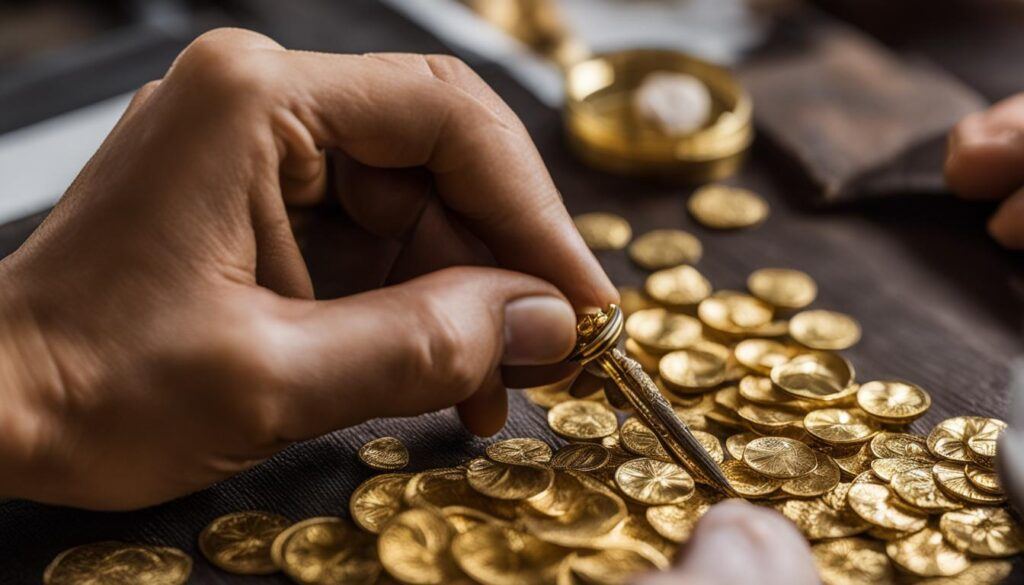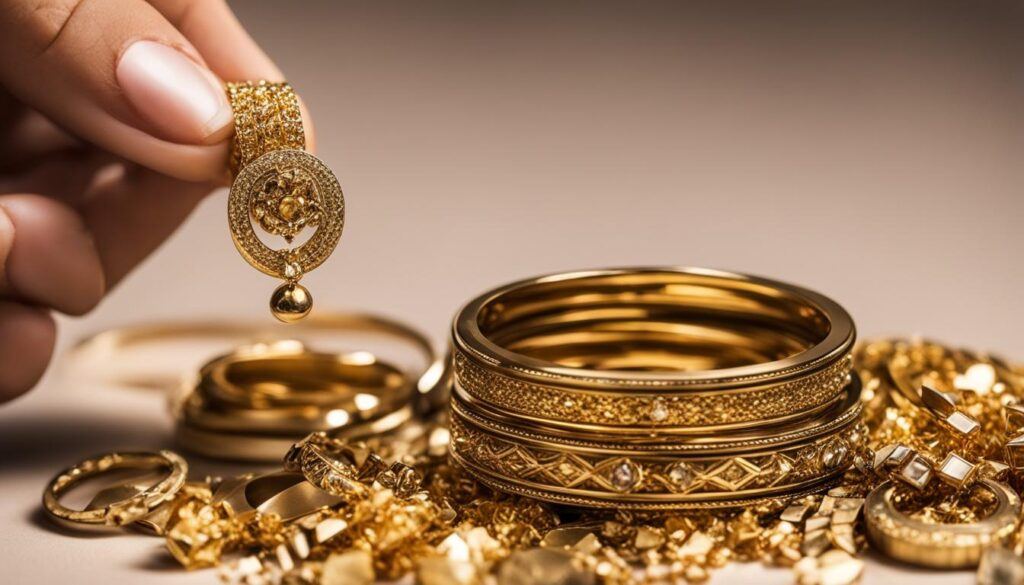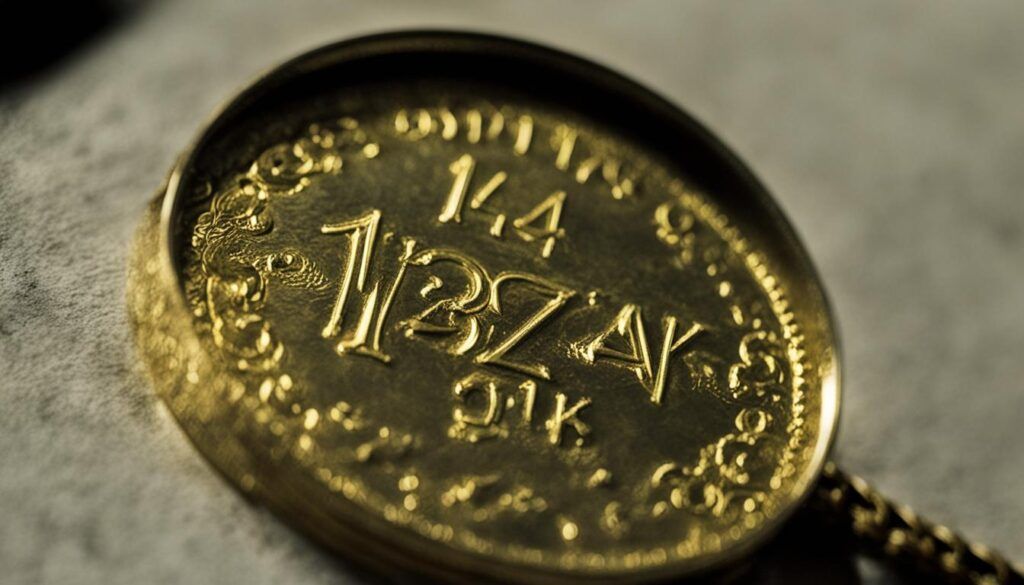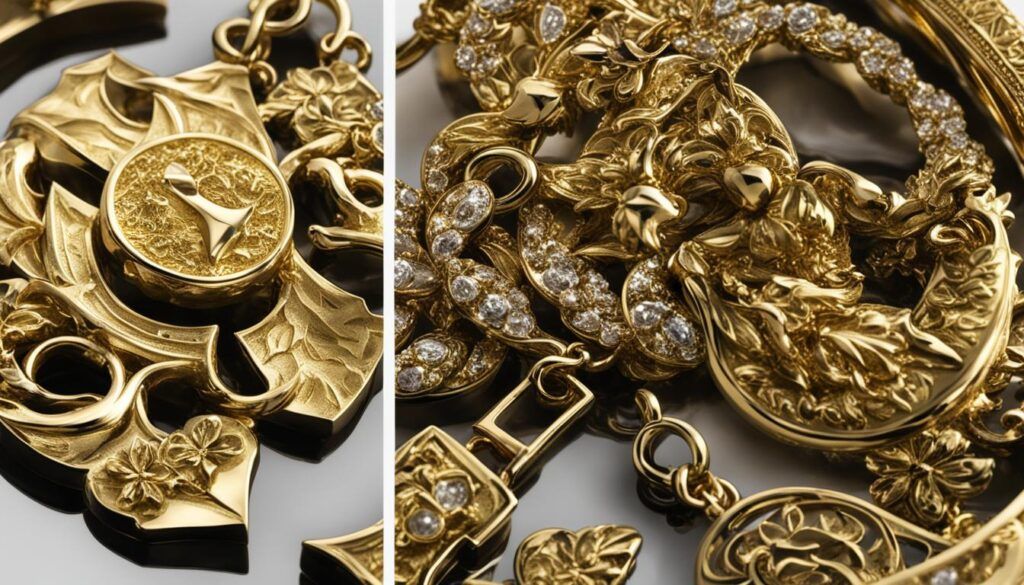Fake gold is a prevalent issue in the jewelry industry, with counterfeit pieces often being sold as genuine. One deceptive tactic used by counterfeiters is stamping fake gold with a 14K mark, making it challenging for consumers to determine its authenticity. However, there are methods available to identify fake gold that can help separate the real from the counterfeit.
Identifying fake gold is crucial when buying or selling jewelry. By understanding the different testing methods and characteristics of real gold, consumers can protect themselves from fraudulent transactions and financial loss. Let’s explore how we can distinguish between fake and genuine gold.
Key Takeaways:
- Fake gold pieces are often stamped with a 14K mark, making it challenging to determine their authenticity.
- To identify fake gold, various testing methods can be used, including examining hallmarks, conducting magnet and acid tests, and seeking professional appraisals.
- Understanding the risks associated with buying or selling fake gold is essential to protect against financial loss and maintain trust in the jewelry market.
- Visual examination, buying from reputable sellers, and practicing caution when encountering too-good-to-be-true deals can help spot fake gold.
- By being informed and cautious, individuals can confidently navigate the gold market and ensure the quality and value of their gold pieces.
Types of Fake Gold
Fake gold can come in different forms, including gold-plated, heavy gold electroplate, and gold-filled items. Gold plating refers to a thin layer of gold applied to a base metal, such as silver or copper. Heavy gold electroplate is a thicker layer of gold, while gold-filled items contain a thicker layer of gold bonded to a base metal. These types of fake gold can be mistaken for real gold, but proper testing methods can help determine their authenticity.
“Gold plating refers to a thin layer of gold applied to a base metal, such as silver or copper. Heavy gold electroplate is a thicker layer of gold, while gold-filled items contain a thicker layer of gold bonded to a base metal.”
When examining gold-plated items, it’s important to note that the gold layer can wear off over time, revealing the base metal beneath. Similarly, heavy gold electroplate and gold-filled items may show signs of wear and tear, which can expose the non-gold base metal.
By understanding the different types of fake gold, individuals can effectively test and determine the authenticity of their gold jewelry, ensuring that they are making informed purchases.
Comparison of Types of Fake Gold
| Type of Fake Gold | Description | Testing Methods |
|---|---|---|
| Gold-plated | A thin layer of gold applied to a base metal | Visual examination, wear and tear assessment |
| Heavy gold electroplate | A thicker layer of gold applied to a base metal | Visual examination, wear and tear assessment |
| Gold-filled | A thicker layer of gold bonded to a base metal | Acid test, professional appraisal |
The Importance of Hallmarks
When it comes to determining the authenticity of gold jewelry, hallmarks play a crucial role. These small engravings or stamps on gold pieces provide valuable information about the karat weight and purity of the gold. By examining the hallmarks, buyers and sellers can make informed decisions and ensure they are getting genuine gold.
“Hallmarks are like the fingerprints of gold, telling us its true identity and quality.”
Hallmarks can be found in various locations on a piece of gold jewelry, such as the clasp, inner band, or surface. They typically consist of a number followed by the letter “K” to represent the karat weight of the gold. For example, a stamp of “14K” indicates that the gold has a purity of 14 karat, meaning it is composed of 58.3% gold and 41.7% other metals.
In addition to karat weight, some hallmarks may use a decimal point followed by a number to indicate the gold content percentage. For instance, a stamp of “.585” represents a gold content of 58.5%.
Checking for these hallmarks is an essential step in identifying the authenticity and quality of gold jewelry. They serve as a guarantee of the gold’s purity and provide valuable information to buyers, ensuring transparency in the marketplace.
Why Are Hallmarks Important?
Hallmarks are important for several reasons:
- Verification of Karat Weight: Hallmarks allow buyers to quickly verify the karat weight of the gold, ensuring they are getting the quality they desire.
- Assurance of Purity: By indicating the gold’s purity, hallmarks provide assurance that the piece is made of genuine gold and not a counterfeit or lower-quality metal.
- Comparison and Value Assessment: Hallmarks allow buyers to compare different gold pieces based on their karat weight and make informed decisions about their value.
Table: Hallmark Stamp Examples and Their Meanings
| Stamp | Meaning |
|---|---|
| 10K | 10 karat gold (41.7% gold content) |
| 14K | 14 karat gold (58.3% gold content) |
| .585 | Gold content of 58.5% |

It is important to note that while hallmarks can provide valuable information, they can also be forged or misleading. Therefore, it is always recommended to consult with a reputable jeweler or have the gold piece professionally appraised to ensure its authenticity.
The Magnet Test
The magnet test is a simple method to determine if gold is genuine or counterfeit. Real gold does not have magnetic properties, so if a piece of jewelry is attracted to a magnet, it is likely to be fake or contain non-gold metals.
However, it’s important to note that the magnet test is not foolproof and may not provide conclusive results. Some counterfeiters may use non-magnetic metals in their fake gold pieces to deceive buyers. Therefore, it is recommended to use additional testing methods to confirm the authenticity of the gold.
For a clearer understanding, refer to the table below for a comparison between real gold and counterfeit gold in terms of their magnetic properties:
| Gold Type | Magnetic Properties |
|---|---|
| Real Gold | Not magnetic |
| Counterfeit Gold | May be magnetic, depending on the non-gold metals used |
As seen in the table, real gold does not exhibit magnetic properties, while counterfeit gold pieces may vary in their magnetic response depending on the presence of non-gold metals.
It is crucial to combine the magnet test with other reliable testing methods to ensure the accurate identification of genuine gold. These methods include examining hallmarks, conducting acid tests, and seeking professional appraisals.
Continue reading to learn more about the acid test, another widely used technique for assessing the purity of gold.
The Acid Test
The acid test is a commonly used method to determine the purity of gold. It involves using nitric acid to observe how gold reacts. A small scratch is made on the gold piece, and a drop of nitric acid is applied to the scratch. If the gold remains unaffected by the acid, it is likely real. If it reacts or dissolves, it indicates a lower purity or non-gold metals. However, it’s important to exercise caution when performing the acid test, as nitric acid can be harmful if mishandled.
Wear and Tear Examination
Examining the wear and tear of a gold item can provide important insights into its authenticity. Real gold is known for its durability and resistance to tarnishing and rusting, while counterfeit gold or gold-plated items may exhibit signs of discoloration or wear over time. By closely observing areas that come into direct contact with the skin, such as the inner band of a ring or the surface of a bracelet, one can detect if the gold plating is beginning to wear off, potentially revealing a base metal underneath.

Gold discoloration and signs of wear and tear can be indicative of counterfeit gold or gold-plated items. Genuine gold, on the other hand, maintains its lustrous appearance and does not tarnish or corrode. The presence of base metal, which is often exposed as the gold plating deteriorates, can also be a telltale sign of inauthentic gold.
When assessing the wear and tear of a gold item, it’s important to pay attention to any noticeable changes in color, texture, or overall condition. Scratches, dents, or fading of the gold surface may suggest that the piece is not made of genuine gold. Additionally, if the gold plating has worn off and a base metal is visible, the item is likely not real gold.
This visual examination of wear and tear serves as an additional layer of verification in determining the authenticity of gold. While it may not be a foolproof method on its own, combining it with other testing techniques, such as the magnet test or acid test, can provide more comprehensive results.
| Signs of Authentic Gold | Signs of Counterfeit Gold |
|---|---|
| Resistant to tarnishing and rusting | Discoloration or signs of wear |
| Lustrous appearance | Fading or dullness |
| No visible scratches or dents | Surface imperfections or scratches |
| No exposure of base metal | Base metal visible due to worn plating |
By carefully examining the wear and tear of a gold item and comparing it to the expected characteristics of genuine gold, individuals can make more informed judgments about its authenticity.
Skin Reaction Test
Some people may experience allergic reactions to certain metals, including base metals used in counterfeit gold. If a gold item causes a green or black mark on the skin after wearing, it is likely not made of real gold. However, it’s important to note that this skin reaction test may not be definitive, as even real gold mixed with other metals can sometimes cause a reaction due to individual sensitivities.
It is essential to be aware of any skin reactions when wearing gold jewelry to ensure both comfort and authenticity. While this test can provide a clue about the composition of the metal, it is best to combine it with other testing methods for a more accurate assessment of gold purity.
Gold Purity and Allergic Reactions
Gold is a hypoallergenic metal, meaning it rarely causes allergic reactions. However, when gold is mixed with other metals to create alloys, such as 14K or 18K gold, the composition can vary, and some individuals may experience sensitivity to certain alloys.
The most common base metals used in gold alloys are copper, silver, and nickel. Nickel, in particular, is a common allergen that can cause skin irritations and allergic reactions in some people. If you are allergic to nickel or other metals commonly used in gold alloys, it is crucial to choose jewelry made from metals that do not contain these allergens.
In general, jewelry made from pure gold (24K) or high-karat gold alloys (such as 22K or 18K) is less likely to cause allergic reactions compared to lower-karat gold alloys.
It is recommended to consult with a dermatologist or allergist if you experience persistent skin reactions to determine the specific metals you are allergic to and avoid them in your jewelry choices.
| Metals | Allergic Reaction Risk | Gold Purity |
|---|---|---|
| Copper | Low risk for allergic reactions | Commonly used in gold alloys |
| Silver | Low risk for allergic reactions | Commonly used in gold alloys |
| Nickel | High risk for allergic reactions | Commonly used in lower-karat gold alloys |
The skin reaction test can be a helpful initial indicator of gold authenticity due to the potential allergic reactions associated with base metals. However, it should be complemented with other gold testing methods to provide a more comprehensive assessment of gold purity. If you suspect you are experiencing an allergic reaction to a particular piece of jewelry, it is recommended to discontinue wearing it and consult with a medical professional.
The Heaviness Test and Magnetization Test
Another way to determine if gold is real is to assess its weight and magnetic properties. Real gold is denser than other metals, so it should feel heavier when compared to fake gold. Additionally, real gold is not magnetic, so it should not be attracted to a magnet. Conducting both the heaviness test and magnetization test can provide further evidence of the authenticity of a gold item.
To perform the heaviness test, hold the gold item in your hand and compare its weight to a known genuine gold item of similar size. Genuine gold should feel noticeably heavier due to its higher density. This test can be subjective and require some experience to differentiate the weight of gold from other materials, so it is advisable to consult with a professional jeweler or use a precision scale for accurate measurements.
The magnetization test is another quick indicator of gold authenticity. Simply place a magnet close to the gold item and observe its reaction. If the gold is attracted to the magnet or exhibits any magnetic properties, it is likely not real gold. However, it’s important to note that this test should not be used as the sole method of determining authenticity, as some counterfeiters may use non-magnetic metals mixed with gold.

By conducting both the heaviness test and magnetization test, you can gather additional evidence to confirm the authenticity of a gold item. Remember to use these tests in conjunction with other methods, such as examining hallmarks and seeking professional appraisals, for a comprehensive assessment.
The Importance of Professional Appraisals
When it comes to determining the authenticity of gold, there are several methods available. However, the most reliable and accurate way to assess the purity and authenticity of gold is through a professional appraisal conducted by a certified jeweler. Seeking the expertise of these professionals is especially crucial when dealing with valuable or sentimental gold items.
A certified jeweler has the knowledge and specialized testing equipment necessary to perform a thorough appraisal. They are trained to identify the subtle differences between genuine gold and fake gold, using accurate testing methods that yield reliable results. By entrusting your gold jewelry to a certified jeweler, you can obtain a professional and unbiased assessment of its authenticity.
During a professional appraisal, the certified jeweler will carefully examine your gold item, taking into consideration its weight, color, and other characteristics. They may also conduct specific tests, such as acid or magnet tests, to further confirm the authenticity of the gold. The results of these tests provide concrete evidence of the gold’s purity and help in making informed decisions regarding its value.
“A professional appraisal conducted by a certified jeweler is the gold standard when it comes to determining the authenticity of gold.”
Not only does a professional appraisal offer accurate and reliable results, but it also provides peace of mind. By obtaining a certified assessment, you can be confident in the authenticity of your gold and make informed decisions about its value. This is particularly important when buying or selling gold, as it helps to avoid fraudulent transactions.
Furthermore, a professional appraisal is the best course of action when dealing with valuable or sentimental gold items. These pieces may hold significant financial or emotional value, and an accurate appraisal ensures that their true worth is reflected.
While there are various methods and tests that can be done at home to identify fake gold, a professional appraisal provides the highest level of expertise and accuracy. It is a valuable investment that guarantees the authenticity and value of your gold jewelry.
So, whether you have a family heirloom or a newly acquired piece of gold jewelry, seeking a professional appraisal from a certified jeweler is essential. It not only confirms the authenticity of your gold but also provides an informed assessment of its value.
The Risks of Fake Gold
Buying or selling fake gold can have serious consequences, leading to significant financial loss and damaging trust in the jewelry market. The prevalence of the counterfeit gold market makes it crucial for individuals to be aware of the risks involved in these transactions. Counterfeiters are constantly finding new ways to deceive buyers, making it important to stay informed and vigilant.
One of the main risks of dealing with fake gold is the potential for financial loss. Fake gold pieces may be sold at prices similar to genuine gold, tricking buyers into paying premium prices for counterfeit items. This can result in a substantial reduction in the buyer’s investment and financial resources.
Fraudulent transactions are another major concern when it comes to fake gold. Buyers may unknowingly purchase counterfeit gold thinking that it is genuine, only to later discover that they have been deceived. Similarly, sellers may inadvertently sell fake gold, causing reputational damage and potentially legal issues.
The counterfeit market for gold is notorious for its sophistication and constantly evolving nature. Counterfeiters go to great lengths to create convincing fake gold pieces, such as using advanced techniques to mimic the appearance and properties of real gold. This makes it increasingly challenging for individuals to spot the fakes and avoid falling victim to fraud.

Understanding how to identify fake gold is crucial in order to mitigate the risks associated with it. By familiarizing themselves with the various testing methods, such as examining hallmarks, conducting magnet and acid tests, and seeking professional appraisals, individuals can make informed decisions when buying or selling gold. It’s important to exercise caution and conduct thorough research to ensure the authenticity of gold items before making any transactions.
Being aware of the risks of fake gold and taking appropriate measures to protect oneself can go a long way in avoiding financial loss and fraudulent transactions. By staying informed and maintaining a skeptical mindset, individuals can navigate the gold market with confidence and maintain the value and integrity of their gold investments.
Tips for Spotting Fake Gold
When it comes to spotting fake gold, there are several key tips to keep in mind. In addition to the testing methods mentioned in previous sections, these tips can help you make informed decisions and minimize the risk of purchasing counterfeit gold.
Visual Examination
One of the first steps in spotting fake gold is to visually examine the piece. Look for signs of poor craftsmanship, such as rough finishes, uneven stamping, or inconsistencies in the gold color. Genuine gold jewelry is typically well-crafted with smooth finishes and precise markings.
Buy from Reputable Sellers
When buying gold, it’s important to choose reputable sellers. Established jewelry stores and reputable online sellers are more likely to sell authentic gold, as they have a reputation to uphold. Be cautious of deals that seem too good to be true, as they may be a red flag for counterfeit gold.
Educate Yourself
Gaining knowledge about the characteristics of real gold can help you spot fake gold more effectively. Familiarize yourself with the weight, color, and texture of genuine gold. Conduct thorough research on reputable sources to learn about the latest techniques used by counterfeiters and how to identify them.
Exercise Caution
When buying gold, exercise caution and take your time making a decision. Avoid impulse purchases and consult with a professional if needed. Remember that genuine gold has a certain value, and if a deal seems too good to be true, it may indicate counterfeit gold.
“A wise buyer is a cautious buyer. Take the time to educate yourself and always be vigilant when purchasing gold jewelry.” – Gold Expert
By following these tips, you can increase your chances of spotting fake gold and making confident purchases. Remember that while testing methods are valuable, being knowledgeable and cautious is equally important in avoiding counterfeit gold.
| Tips for Spotting Fake Gold |
|---|
| Visual Examination |
| Buy from Reputable Sellers |
| Educate Yourself |
| Exercise Caution |
Conclusion
In conclusion, identifying fake gold and determining whether it can be stamped as 14K requires a combination of testing methods. By examining hallmarks, conducting magnet and acid tests, and seeking professional appraisals, individuals can confidently assess the authenticity of their gold jewelry.
These testing methods play a crucial role in protecting against the risks of buying or selling fake gold. Counterfeit gold is prevalent in the market, and consumers need to be informed and cautious to avoid financial loss and fraudulent transactions.
By staying informed about the characteristics of real gold and conducting thorough research before making a purchase, individuals can navigate the gold market with confidence. It is essential to prioritize buying from reputable sellers and being vigilant of deals that seem too good to be true. These steps help ensure the quality and value of gold pieces and prevent falling victim to the counterfeit market.
FAQ
Can fake gold be stamped 14K?
Yes, counterfeit gold can be stamped with a 14K mark to deceive buyers into thinking it is real. However, there are methods to identify fake gold and determine its authenticity.
What are the different types of fake gold?
Fake gold can come in various forms, including gold-plated, heavy gold electroplate, and gold-filled items. These types of fake gold can be mistaken for real gold but can be identified through proper testing methods.
How important are hallmarks in determining gold authenticity?
Hallmarks, which are small engravings or stamps on gold jewelry, are crucial in determining the purity and authenticity of gold. They indicate the karat weight or gold content and can be found on the clasp, inner band, or surface of the piece.
Can the magnet test help identify fake gold?
Yes, the magnet test is a simple method to determine if gold is real or fake. Real gold is not magnetic, so if a piece of jewelry is attracted to a magnet, it is likely fake or contains non-gold metals. However, additional testing methods should be used to confirm the authenticity of the gold.
What is the acid test for gold authenticity?
The acid test involves using nitric acid to determine the purity of gold. By observing how gold reacts to the acid, such as remaining unaffected or dissolving, one can identify its authenticity. It is important to exercise caution when performing this test and use appropriate safety measures.
What can wear and tear examination reveal about gold authenticity?
Real gold is resistant to tarnishing and rusting, while counterfeit gold or gold-plated items may show signs of discoloration or wear. Examining the wear and tear of a gold item, particularly areas that come into direct contact with the skin, can provide clues about its authenticity.
Can a skin reaction test help identify fake gold?
Yes, conducting a skin reaction test can provide insight into the authenticity of gold. Base metals used in counterfeit gold can cause allergic reactions, resulting in green or black marks on the skin. However, this test may not be definitive as even real gold mixed with other metals can sometimes cause reactions due to individual sensitivities.
Are the heaviness test and magnetization test effective in determining gold authenticity?
Yes, the heaviness test and magnetization test can provide further evidence of gold authenticity. Real gold is denser than other metals, making it feel heavier when compared to fake gold. Additionally, real gold is not magnetic and should not be attracted to a magnet.
How important are professional appraisals in assessing gold authenticity?
Professional appraisals conducted by certified jewelers are the most reliable way to assess the purity and authenticity of gold. These experts have the knowledge and specialized testing equipment to accurately determine the authenticity of gold, especially for valuable or sentimental items.
What are the risks associated with buying or selling fake gold?
Buying or selling fake gold can lead to significant financial loss and damage trust in the jewelry market. The counterfeit gold market is prevalent, with counterfeiters constantly finding new ways to deceive buyers. Identifying fake gold and making informed decisions when buying or selling is essential to avoid these risks.
What are some tips for spotting fake gold?
Visual examination can reveal signs of poor craftsmanship, such as rough finishes or uneven stamping, which could indicate fake gold. Buying from reputable sellers and being cautious of deals that seem too good to be true can also help identify and avoid fake gold. Educating oneself about the characteristics of real gold and conducting thorough research before making a purchase are essential practices to reduce the risk of buying fake gold.



